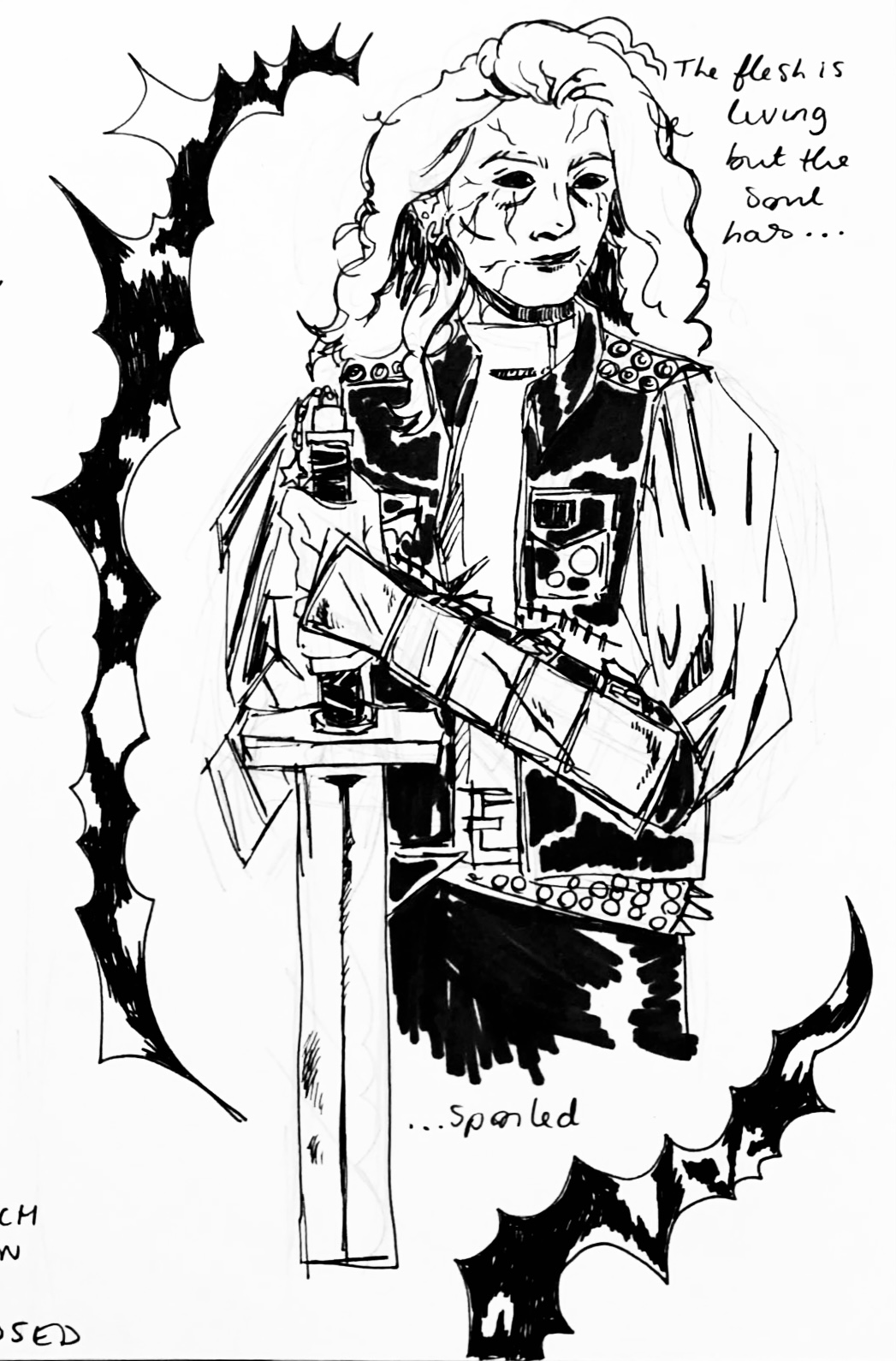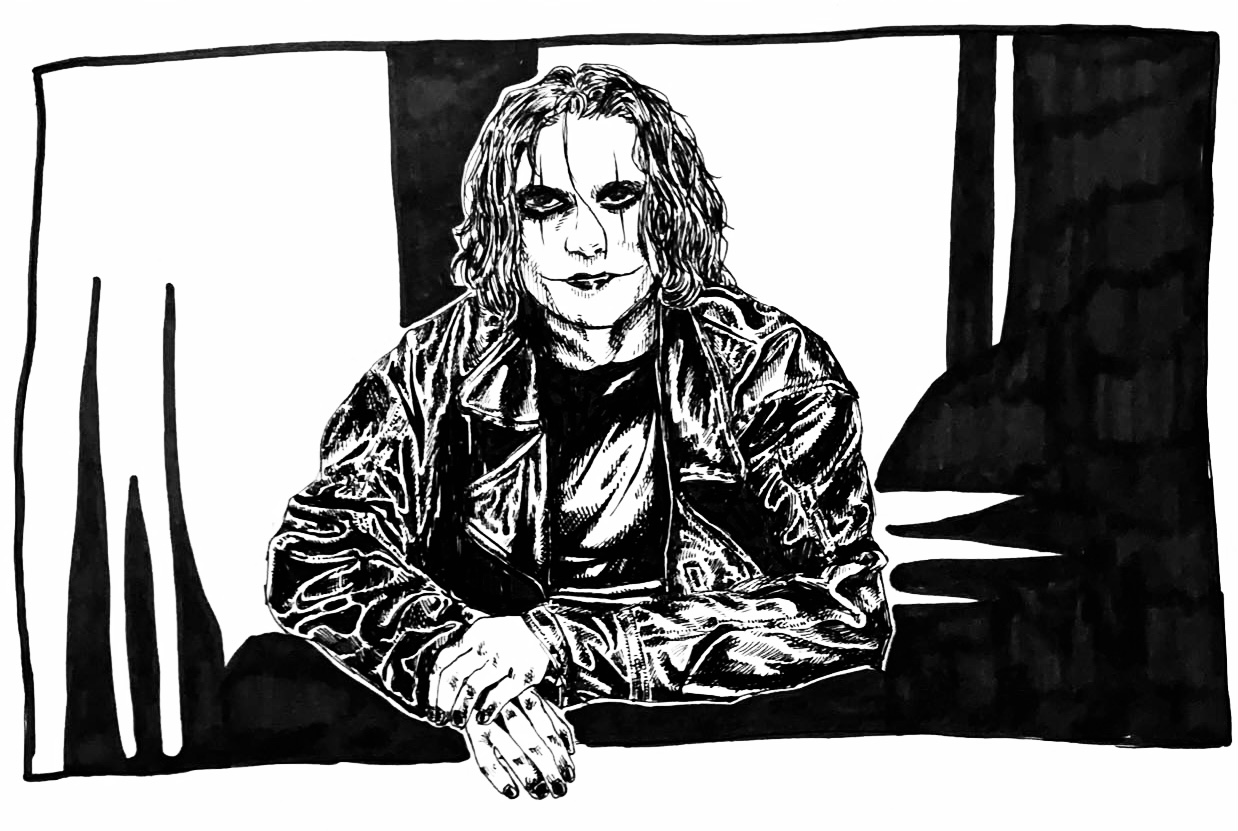
When I was trying to cultivate a face that would best suit me, I also took heavy inspiration from the music I listened to, or rather, didn't listen to. I loved corpse paint and how it looked, and the stories from the scene it originated in- I didn't really love the music it is associated with. Black metal was too heavy for me, though I never told anyone that at the time. I guess I'm a poseur in every sense of the word.

Examples of black and white make-up used in rock performance: (left to right) Alice Cooper, Gene Simmons (of the band 'KISS'), and Doyle Wolfgang von Frankenstein.
Stylised black and white make-up has been a thing in alternative music since forever. It's about looking uber extreme and different because your music is hardcore and scary. However, I didn't care about Alice Cooper or 'KISS', so this isn't about them. Admittedly, it's a little bit about Doyle, because I did care a lot about him and his work in 'Misfits' and, uh, Doyle, but at the time, my main source of inspiration was at the so-called source of 'true Norwegian black metal'.
Mayhem
The band 'Mayhem' was formed in 1984 and has had a revolving door of members, so I'll only bring up the ones I deem relevant (sorry to any hardcore 'Mayhem' fans, one of which I am not). The story of the band is infamous, and it was this, rather than their actual music, that I was interested in. There are of course conflicting reports (a classic thing when people ascribe the credit for something onto someone), but most people say that 'Mayhem's former lead singer, Per 'Dead' Ohlin was the one to come up with the term 'corpse paint' to describe the black and white make-up look he favoured. This is because, to Dead, it wasn't cosmetic- he utilised it to because he wanted to look like a corpse.
I think of Dead often: a man with a history of self-mutilation and mental illness, particularly apparent Cotard's Syndrome. Dead believed he was dead. He would allegedly surround himself with animal corpses, some to keep to smell before a show so that he could sing with 'the stench of death still in his throat'. Indeed, prior to joining 'Mayhem', he enclosed, with his audition tape, a rat's corpse. His self-harming was not a private affair- he did it on stage and he did it in front of friends. When performing, he would wear an outfit that he had buried in the ground a few days before the show, to fully embody the dead thing he saw himself as. Allegedly, he spoke of being non-human, other, not made for the world, and belonging somewhere else. Dead killed himself in 1991.

Per 'Dead' Ohlin
By some accounts, fellow 'Mayhem' band member Oysten 'Euronymous' Aarseth endorsed Dead's delusions and behaviour, and increased the tension between the pair for up to a year before Dead's suicide because he believed it furthered the band's image. Whether you believe this or not, what is indisputable is that upon finding Dead's body, Euronymous rearranged the weapons Dead had used to take his own life, and took photographs: one such photograph later became the cover art for a bootleg 'Mayhem' concert album.
What sticks with me is that Dead did not use corpse paint to embody a stage persona, but to become who he thought he truly was- I wanted that.
At the time, corpse paint reminded me of the black-veined remnants from 'Skulduggery Pleasant'. TL;DR, 'Skulduggery' is a series of kids books that I have been obsessed with for thirteen years. They're widely about a hidden magical subculture, and the governments that police it, but follow a living skeleton detective, Skulduggery Pleasant, and his teenage apprentice, Valkyrie Cain, both of whom work for the magical governing body in Ireland.

Tanith Low from 'Skulduggery Pleasant', possessed by a remnant.
In the fifth 'Skulduggery' book ('Mortal Coil'), the antagonists are remnants, disembodied dark souls that possess people and turn them insane. My favourite character in the books was Tanith Low, an ex-assassin turned knight-figure, who harbours some minor antiestablishment viewpoints. She bounty-hunts on a freelance basis, trying to help people without being curtailed by the red-tape of the magical government in her native London- her opposition to authority also stops her from taking a permanent position within this system. Initially, this points to her moral goodness, as the books frequently centre on corruption within the magical governing systems. However, when she becomes possessed by a remnant, Tanith is obsessed with the idea of destroying the magical governments and most of the rest of the world, feeling that it would be better if the slate was wiped clean and started again. She frequently refers to this destruction as 'beautiful'. She is so hellbent on annihilation that she is willing to use her surrogate little sister figure Valkyrie Cain, who is prophesied to become to world-ending God Darquesse, to achieve this. She is also willing to forsake herself for her goal.
"But I don't matter. Only she [Darquesse] matters." - Tanith (remnant) in 'The Maleficent Seven', Derek Landy, p278.
Those possessed by remnants are marked out by their black eyes, lips, and gums, and the black veins beneath their skin. Tanith can hide the symptoms of possession, but frequently allows them to show while she fights as a sort of scare tactic.
"Have mercy."
She smiled with black lips, and showed him the veins beneath her skin. "I'm all out."
- 'Kingdom of the Wicked', Derek Landy, p173.The marks of possession represent a penchant for extermination, violence, and insanity. They show that the person they appear on makes no distinction between friend, foe, or self. It's nihilism and sickness overall. It shares many of the tenets of what corpse paint represents- or at least the image of what the band that wears it is trying to convey.
A remnant inspired corpse paint mock-up.
I'll not mince words- that's what I wanted. I wanted to look like something was wrong with me, because that's how I felt and that's what I wanted people to know about me at a glance. The rest of the story of 'Mayhem', briefly; Euronymous later hired an associate, Kristian 'Varg' Vikernes, as a bass player. Varg stabbed Euronymous (he did a few other things too, and obviously there is build up to this, but I'm just skimming). Euronymous died, Varg went to prison. 'Mayhem' (comprised of Jorn 'Necrobutcher' Stubberud, Jan 'Hellhammer' Blomberg, Attila Csihar, Morten 'Teloch' Iverson, and Charles 'Ghul' Hedger) continue to make music.
Mayhem
Back when I was into all this, I didn't even know that one of 'Mayhem's biggest inspirations, and a band fundamental to the creation of black metal as a genre, 'Venom', hails from here: Newcastle. I fucking love my hometown. I guess black metal is in our veins here, in a weird way, even though we're far from Norway. Makes me feel better about a lot.
I'm making corpse paint sound very negative, but to me, it presents a positive: being damned and not caring, or turning your own mortality into a symbol. It's a sort of devil-may-care attitude, but with a keen awareness of death and your own shortcomings. There is, then, Eric Draven, a character in Alex Proyas's 1994 movie 'The Crow' (based on a comic by James O'Barr of the same name) who dons what I would loosely call corpse paint, and is a hero.

Eric Draven in 'The Crow'
"You move, you're dead."
"And I say "I'm dead," and I move."
In the movie, Eric is a heavy-metal guitarist for the band 'Hangman's Joke'. On Halloween-Eve, the night before their wedding, Eric and his fiance Shelly are attacked by gangbangers: Shelly is sexually assaulted and Eric is stabbed and forced to watch, before being shot and pushed from a window, falling to his death. Shelly is taken to hospital and spends thirty hours in intensive care, but ultimately succumbs to her injuries. A crow with supernatural powers revives Eric on the one-year anniversary of his death, imbuing him with invulnerability. Though Eric knows his return is only temporary, he doesn't care- his only goal is to get revenge on the gangbangers one by one. He wants to write wrongs, but knows that in the end, nothing can change the fact that he and Shelly are both dead. He feels little to no pain when the gangbangers fight back, and eventually kills their leader by psychically transferring Shelly's thirty hours of pain to him. He returns to the grave and is re-united with Shelly.
Corpse paint in 'The Crow' is a death-wish and a promise. It is a mark of impermanence, but shows the strength of the impact you can make with what little time or what little life you have left. Like Eric's psychic transfer of Shelly's pain, corpse paint is an externalisation of something kept inside.